TRACKED VEHICLES Stuart:
A History of the American Light Tank, by R.P. Hunnicutt, Presidio Press,
1992, ISBN 0-89141-462-2 ($100). Stuart:
A History of the American Light Tank, by R.P. Hunnicutt, Presidio Press,
1992, ISBN 0-89141-462-2 ($100).
Hunnicutt
is the author of several "bibles" of U.S. AFVs, including the Sherman,
the Pershing, the half-track and this epic tome, which runs over 500 pages. He
produces an exhaustive history of the development of these vehicles, their variants
and offspring. For example, the Stuart book also explores the M24 Chaffee, amphibian
tanks like the Buffalo, and gun motor carriages like the M8 and M19. There are
scads of diagrams and tech manual photos to help you replicate every imaginable
detail, as well as numerous pictures of the vehicles on the battlefields. These
books are understandably pricey, but you can often get good deals through online
booksellers. My wife picked up this book for me in pristine condition, sans dust
jacket, for only $50 at an antique store! A
Field Guide to the M5 Series Light Tanks and the M8 Howitzer Motor Carriage,
by Kurt Laughlin, 2008, self-published ($20). 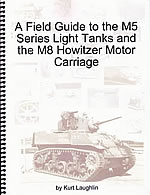 Kurt
Laughlin is widely respected as font of knowledge on the technical construction
and usage of U.S. AFVs of WWII. He's provided much information on this website
and to me personally for my projects. An engineer by profession, he's got an eye
for detail that is appreciated by modelers who seek to make corrections or add
the appropriate features missing from their kits. His examination of the Stuart
series, as fielded by the U.S. Army, explores the significant and subtle external
differences between the variants, from their suspensions to the tops of their
turrets. The M8 HMC gets less coverage due to the sameness of its hull to its
light tank counterparts; additional photos of the M8 turret would be welcomed
here. But if you are looking to model a specific Stuart and want to know how changes
in work orders and modifications were introduced, this provides a highly readable
narrative and lists the production date ranges, serial numbers, and registration
numbers for the vehicles, as well as their manufacturers. This is a good companion
to the other Stuart references on this page, and for many modelers it would be
an adequate substitute for the pricier and out-of-print Hunnicutt volume. Read
Kurt's review
of the M5A1 Stuart from AFV Club and errata for his book. Kurt
Laughlin is widely respected as font of knowledge on the technical construction
and usage of U.S. AFVs of WWII. He's provided much information on this website
and to me personally for my projects. An engineer by profession, he's got an eye
for detail that is appreciated by modelers who seek to make corrections or add
the appropriate features missing from their kits. His examination of the Stuart
series, as fielded by the U.S. Army, explores the significant and subtle external
differences between the variants, from their suspensions to the tops of their
turrets. The M8 HMC gets less coverage due to the sameness of its hull to its
light tank counterparts; additional photos of the M8 turret would be welcomed
here. But if you are looking to model a specific Stuart and want to know how changes
in work orders and modifications were introduced, this provides a highly readable
narrative and lists the production date ranges, serial numbers, and registration
numbers for the vehicles, as well as their manufacturers. This is a good companion
to the other Stuart references on this page, and for many modelers it would be
an adequate substitute for the pricier and out-of-print Hunnicutt volume. Read
Kurt's review
of the M5A1 Stuart from AFV Club and errata for his book.
M5A1
Stuart, by Krzysztof Mucha and George Parada, Kagero, 2003, ISBN 83-89088-04-5
($28). 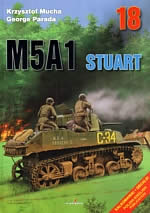 If
you can't find the Hunnicutt book, this slim paperback and Steven Zaloga's Concord
publication below are the next best thing. Written in both Polish and English,
this book is thin on historical photos, but offers some eyepopping exterior and
interior details, many in color. There are also numerous scale drawings of early
and late variants. To top it off are color plates and decals for 10 Stuarts crewed
by Poles, Brits, and Americans (including the often seen "Concrete"
and "Africa" tanks). It may seem a bit pricey, but the color images
and exquisite decals make this book more than worthwhile. If
you can't find the Hunnicutt book, this slim paperback and Steven Zaloga's Concord
publication below are the next best thing. Written in both Polish and English,
this book is thin on historical photos, but offers some eyepopping exterior and
interior details, many in color. There are also numerous scale drawings of early
and late variants. To top it off are color plates and decals for 10 Stuarts crewed
by Poles, Brits, and Americans (including the often seen "Concrete"
and "Africa" tanks). It may seem a bit pricey, but the color images
and exquisite decals make this book more than worthwhile.
M5A1 Stuart Walkaround CD, by Chris "toadman"
Hughes, www.toadmanstankpictures.com ($8)
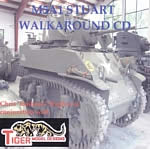 Chris
provided me with a copy of this walkaround of the Stuart in the Jacques Littlefield
collection. The disc contains over 200 photos of this tank, which has been lovingly
restored. The photos are crisp and provide a wealth of details for modelers who
want to investigate every nook and cranny of the exterior and interior fighting
compartments. The only downside is that you'll want to buy a laptop so you can
have quick access to this great reference as you're building. Chris
provided me with a copy of this walkaround of the Stuart in the Jacques Littlefield
collection. The disc contains over 200 photos of this tank, which has been lovingly
restored. The photos are crisp and provide a wealth of details for modelers who
want to investigate every nook and cranny of the exterior and interior fighting
compartments. The only downside is that you'll want to buy a laptop so you can
have quick access to this great reference as you're building.
U.S.
Light Tanks at War 1941-1945, by Steven J. Zaloga, Concord Publications,
1999, ISBN 962-361-678-3 ($16). 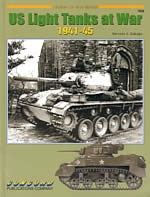 This
is another great pictorial book of the Stuart variants and follow-on Chaffees
in combat settings. Zaloga goes over the development of the U.S. light tank in
three concise pages and offers some interesting photos of the early M1 combat
car and M2 light tank, which led the way to the M3 series. Early combat in North
Africa and the Far East is shown before the bulk of the book moves to Italy and
Northern Europe. The Chaffee appears in 1944, and there are a few photos of the
Locust airborne tank. The book includes 16 color plates. This
is another great pictorial book of the Stuart variants and follow-on Chaffees
in combat settings. Zaloga goes over the development of the U.S. light tank in
three concise pages and offers some interesting photos of the early M1 combat
car and M2 light tank, which led the way to the M3 series. Early combat in North
Africa and the Far East is shown before the bulk of the book moves to Italy and
Northern Europe. The Chaffee appears in 1944, and there are a few photos of the
Locust airborne tank. The book includes 16 color plates.
Toadman's Light Tank
M24 Photo Detail CD, by Chris "toadman" Hughes,
www.toadmanstankpictures.com ($8)
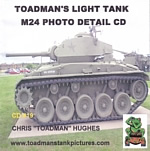 The
M24 doesn't get many props for its role as the replacement for the M5 Stuart as
the main light recon tank in the closing months of WWII. Perhaps that's due in
part to the initial Italeri kit from the early 1980s, based on a Korean version.
The company's reworking of the kit to WWII standards some 20 years later still
has some minor problems. A resin update set from Formations replaces most of the
Italeri kit. But any of these kits will benefift from having this CD close at
hand. Toadman offers walk-arounds of four different M24s. Along with the usual
photos of exterior details, this album also includes some fantstic interior photos
of the drivers' positions in the hull, the turret, and the engine compartment.
Thanks to Chris for the review sample. The
M24 doesn't get many props for its role as the replacement for the M5 Stuart as
the main light recon tank in the closing months of WWII. Perhaps that's due in
part to the initial Italeri kit from the early 1980s, based on a Korean version.
The company's reworking of the kit to WWII standards some 20 years later still
has some minor problems. A resin update set from Formations replaces most of the
Italeri kit. But any of these kits will benefift from having this CD close at
hand. Toadman offers walk-arounds of four different M24s. Along with the usual
photos of exterior details, this album also includes some fantstic interior photos
of the drivers' positions in the hull, the turret, and the engine compartment.
Thanks to Chris for the review sample.
Sherman:
A History of the American Medium Tank, R.P. Hunnicutt, Presidio Press,
1978, 1994; reprinted by Historical Archive Press, 2007, ISBN 089-141-080-5. ($130)
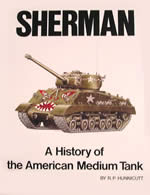 This
is THE book, at long last in print again, detailing the technical development
of the medium tank, from the M3 Lee through the Sherman's last action in the Korean
War. Chocked full of engineering details, it offers more to the serious modeler
interested in hardware and mechanical minutiae than probably any other book. For
more casual modelers, it may be overkill. But many of the surface differences
between variants are capably covered by other books, and other volumes have more
extensive photograph collections. This
is THE book, at long last in print again, detailing the technical development
of the medium tank, from the M3 Lee through the Sherman's last action in the Korean
War. Chocked full of engineering details, it offers more to the serious modeler
interested in hardware and mechanical minutiae than probably any other book. For
more casual modelers, it may be overkill. But many of the surface differences
between variants are capably covered by other books, and other volumes have more
extensive photograph collections.
Armored
Thunderbolt, The U.S. Amry Sherman in World War II,
by Steven Zaloga, Stackpole Books, 2008, ISBN 978-0-8117-0424-3 ($35)  This
book is an excellent complement to Hunnicutt's "bible." Zaloga briefly
covers the development of the Sherman, but most of his focus is on how the tank
performed on the battlefield and how armored doctrine and tactics were recast
as the tank came up against German and Japanese armor. Photos run from pre-war
predecessors up to the final Cold War variants, picking up Tunisia, Italy, Tarawa,
Normandy, the Bulge, and Iwo Jima along the way. A number of pictures have graced
other Zaloga books, but there are many fresh combat images. For the wonks among
us, there are plenty of strength and loss stats and production runs at the various
factories, if you want to make sure your Archer Fine Transfer casting marks are
on the right tank at the right time. If you're interested in how the Sherman helped
the Allies prevail on the battlefield against techically superior armor, this
book will school you. This
book is an excellent complement to Hunnicutt's "bible." Zaloga briefly
covers the development of the Sherman, but most of his focus is on how the tank
performed on the battlefield and how armored doctrine and tactics were recast
as the tank came up against German and Japanese armor. Photos run from pre-war
predecessors up to the final Cold War variants, picking up Tunisia, Italy, Tarawa,
Normandy, the Bulge, and Iwo Jima along the way. A number of pictures have graced
other Zaloga books, but there are many fresh combat images. For the wonks among
us, there are plenty of strength and loss stats and production runs at the various
factories, if you want to make sure your Archer Fine Transfer casting marks are
on the right tank at the right time. If you're interested in how the Sherman helped
the Allies prevail on the battlefield against techically superior armor, this
book will school you.
The
M4 Sherman at War, The European Theatre 1942-1945, by Steven J. Zaloga,
Concord Publications, 1994, ISBN 962-361-603-1 ($15). The
M4 Sherman at War (2) The U.S. Army in the European Theater
1943-45, by Steven J. Zaloga, Concord Publications, 2000, ISBN 962-361-669-4.
($15) 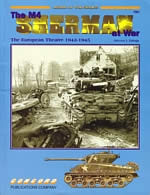 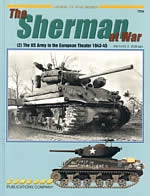 Nearly
any book by Steve Zaloga is worth having on your shelf. These two Concord publications
follow the same structure: several pages of narrative overview and then loads
of pictures, including color illustrations. Both books will provide keen insights
for modelers and diorama builders. Nearly
any book by Steve Zaloga is worth having on your shelf. These two Concord publications
follow the same structure: several pages of narrative overview and then loads
of pictures, including color illustrations. Both books will provide keen insights
for modelers and diorama builders.
M4
Sherman, Combat and Development History of the Sherman Tank and All Sherman Variants,
by Michael Green, Motorbooks International, 1993, ISBN 0-87938-803-X ($25).
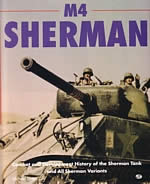 In
my opinion, Michael Green is right up there with Zaloga for producing books of
great interest to modelers. They tend to be heavier on the narrative side than
Zaloga's, but that's not a bad thing. The firsthand tank crew accounts are compelling
and provide a human dimension to these mechanical beasts. This book has many useful
interior photos of the Sherman variants, and a number of historical and contemporary
exterior photos are in color. Coverage extends to the Korean War and Israeli usage. In
my opinion, Michael Green is right up there with Zaloga for producing books of
great interest to modelers. They tend to be heavier on the narrative side than
Zaloga's, but that's not a bad thing. The firsthand tank crew accounts are compelling
and provide a human dimension to these mechanical beasts. This book has many useful
interior photos of the Sherman variants, and a number of historical and contemporary
exterior photos are in color. Coverage extends to the Korean War and Israeli usage.
Toadman's M4A3(76) HVSS and M4A2(76)
HVSS Sherman Walkaround CD, by Chris "toadman" Hughes, CD #8,
www.toadmanstankpictures.com ($8).
%20HVSS.jpg) Insert
this CD-ROM into your computer and you're instantly transported to the Military
Vehicle Technology Foundation in California, home of the infamous Jacques Littlefield
collection. You get up close and friendly with an M4A3(76) and M4A2(76) in fine
condition. There are approximately 400 photos on this disc covering the essential
attributes of these tanks, and Hughes points out similarities and differences
between the two where applicable. There's no deep historical or technical analysis
here; this is a visual feast for the modeler who wants to get the lift ring weld
seams right or install the brackets that secure the exhaust deflectors when work
is done on the rear of the tank, so each photo has only a brief identifying comment.
Alternate types of tracks and drive sprockets are shown, and there are great interior
photos of the hull and turret, but no engine compartment images. If you want to
know what three (or four) colors to paint your periscopes, this is the guide for
you. Insert
this CD-ROM into your computer and you're instantly transported to the Military
Vehicle Technology Foundation in California, home of the infamous Jacques Littlefield
collection. You get up close and friendly with an M4A3(76) and M4A2(76) in fine
condition. There are approximately 400 photos on this disc covering the essential
attributes of these tanks, and Hughes points out similarities and differences
between the two where applicable. There's no deep historical or technical analysis
here; this is a visual feast for the modeler who wants to get the lift ring weld
seams right or install the brackets that secure the exhaust deflectors when work
is done on the rear of the tank, so each photo has only a brief identifying comment.
Alternate types of tracks and drive sprockets are shown, and there are great interior
photos of the hull and turret, but no engine compartment images. If you want to
know what three (or four) colors to paint your periscopes, this is the guide for
you.
U.W. WWII
M4/M4A1 Sherman Medium Tank,
Michael Franz, editor, Tankograd Publishing, 2006 ($20).
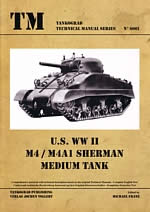 This
slim volume is a good introduction to some of the mechanical features of these
Sherman variants wihtout sinking an arm and a leg into the Hunnicutt tome. In
48 pages and text in English and German, it offers a strong selection of images
from the original technical manuals that can help you represent the essential
interior layouts to satisfy "through the hatch" viewing. It also includes
some images of the 105mm howitzer turret and gun mount, and a good section on
the deep water fording kit. Images of the flamethrower M42B1 are interesting,
but a couple shots of an M4 with the T1E3 mine-roller and photo of bulldozer mounted
on an M4A1(76)W are somewhat superfluous. This
slim volume is a good introduction to some of the mechanical features of these
Sherman variants wihtout sinking an arm and a leg into the Hunnicutt tome. In
48 pages and text in English and German, it offers a strong selection of images
from the original technical manuals that can help you represent the essential
interior layouts to satisfy "through the hatch" viewing. It also includes
some images of the 105mm howitzer turret and gun mount, and a good section on
the deep water fording kit. Images of the flamethrower M42B1 are interesting,
but a couple shots of an M4 with the T1E3 mine-roller and photo of bulldozer mounted
on an M4A1(76)W are somewhat superfluous. Sherman
in Action, by Bruce Culver, Squadron/Signal Publications, Inc., 1977,
ISBN 0-89747-049-4 ($9). 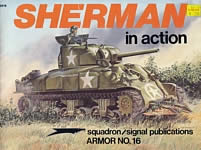 This
is among the earliest of the series of slim "In Actoin" books from Squadron/Signal
Publications. They provide an inexpensive entry point for the modeler just beginning
to get into specific U.S. armor vehicles. There's always a pithy analysis of changes
between vehicle variants, and black and white drawings point out distinguishing
differences. Illustrator Don Greer provides a center color spread of eight tanks
that can help determine typical colors and markings. This
is among the earliest of the series of slim "In Actoin" books from Squadron/Signal
Publications. They provide an inexpensive entry point for the modeler just beginning
to get into specific U.S. armor vehicles. There's always a pithy analysis of changes
between vehicle variants, and black and white drawings point out distinguishing
differences. Illustrator Don Greer provides a center color spread of eight tanks
that can help determine typical colors and markings.
U.S.
Tank Destroyers in Combat 1941-1945, by Steven J. Zaloga, Concord Publications,
1996, ISBN 962-361-609-0 ($15). 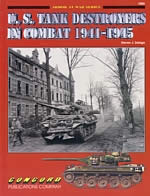 The
M10 and M36 series are well represented in action photos, along with the M18 Hellcat
and the short-lived M3 75mm Gun Motor Carriage (built on the M3 halftrack) and
M6 37mm GMC (using the Dodge 3/4 ton weapons carrier as a platform). Sixteen plates
of color illustrations, including two M36s from the Croatian army during the early
1990s fighting in the Balkans. The
M10 and M36 series are well represented in action photos, along with the M18 Hellcat
and the short-lived M3 75mm Gun Motor Carriage (built on the M3 halftrack) and
M6 37mm GMC (using the Dodge 3/4 ton weapons carrier as a platform). Sixteen plates
of color illustrations, including two M36s from the Croatian army during the early
1990s fighting in the Balkans.
U.S.
Tank Destroyers in Action, by Jim Mesko, Squadron/Signal Publications,
Inc., 1998, ISBN 0-89747-385-X ($9). 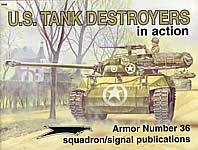 These
slim books from Squadron/Signal Publications are fantastic for the modeler just
beginning to get into U.S. Armor or specific vehicles. There's always a pithy
analysis of changes between vehicle variants, and black and white drawings point
out distinguishing differences. There's always a center spread of color illustrations
by Don Greer that can help determine typical colors and markings. These
slim books from Squadron/Signal Publications are fantastic for the modeler just
beginning to get into U.S. Armor or specific vehicles. There's always a pithy
analysis of changes between vehicle variants, and black and white drawings point
out distinguishing differences. There's always a center spread of color illustrations
by Don Greer that can help determine typical colors and markings.
Walk
Around: U.S. Tank Destroyers, by Jim Mesko, Squadron/Signal Publications,
Inc., 2003, ISBN 0-89747-456-2 ($15). 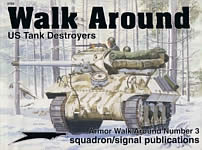 The
third in the "Walk Around" series from Squadron, this book is a good
companion to Mesko's U.S. Tank Destroyers in Action. There is plenty of
color photos interspersed among the B&W shots of the interiors and exteriors
of the M10, M10A1, M18, and M36 series of tank busters. Most of the photos are
of restored vehicles, as well as a few historical images. There a few line drawings
from Darren Glenn and Dave Gebhardt, and fourteen color illustrations from Don
Greer. This book will help modelers who want to do some extra detailing, particularly
of the interiors of these open-topped turrets. The only significant omissions
I found were an absence of photos of the ammo layout in the M36 and M36B2. In
these vehicles, changes in the M10 hull layout were necessary to accommodate the
longer 90mm rounds stowed on the hull sponsons. However, there are a couple photos
of the ammo stowage areas on the sponsons of the M36B1, the briefly produced version
which used the Sherman hull. All in all, it's not as exhaustive as a Hunnicutt
study, but it's enough for most modelers and at a very reasonable price. The
third in the "Walk Around" series from Squadron, this book is a good
companion to Mesko's U.S. Tank Destroyers in Action. There is plenty of
color photos interspersed among the B&W shots of the interiors and exteriors
of the M10, M10A1, M18, and M36 series of tank busters. Most of the photos are
of restored vehicles, as well as a few historical images. There a few line drawings
from Darren Glenn and Dave Gebhardt, and fourteen color illustrations from Don
Greer. This book will help modelers who want to do some extra detailing, particularly
of the interiors of these open-topped turrets. The only significant omissions
I found were an absence of photos of the ammo layout in the M36 and M36B2. In
these vehicles, changes in the M10 hull layout were necessary to accommodate the
longer 90mm rounds stowed on the hull sponsons. However, there are a couple photos
of the ammo stowage areas on the sponsons of the M36B1, the briefly produced version
which used the Sherman hull. All in all, it's not as exhaustive as a Hunnicutt
study, but it's enough for most modelers and at a very reasonable price.
HALF-TRACKSHalf-Track,
A History
of American Semi-Tracked Vehicles, R.P. Hunnicutt, Presidio Press, 2001,
ISBN 0-89141-742-7 ($80). 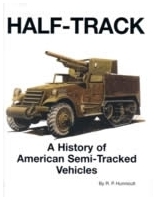 With
fewer variants and mechanical complexities, this book comes in at (appropriately)
half the size of the fully tracked Sherman and Stuart books penned
by Hunnicutt. What makes it particularly valuable to modelers is the wealth of
interior photos, detailed tech manual images of various components, five-view
drawings from Michael Duplessis, and a concise narrative outlining the vehicle's
development from WWI to Korea. An excellent companion for the new DML kits—or
those old Tamiya models you might wish to upgrade. With
fewer variants and mechanical complexities, this book comes in at (appropriately)
half the size of the fully tracked Sherman and Stuart books penned
by Hunnicutt. What makes it particularly valuable to modelers is the wealth of
interior photos, detailed tech manual images of various components, five-view
drawings from Michael Duplessis, and a concise narrative outlining the vehicle's
development from WWI to Korea. An excellent companion for the new DML kits—or
those old Tamiya models you might wish to upgrade.
U.S.
Half-tracks in Combat 1941-1945, by Steven J. Zaloga, Concord Publications,
1999, ISBN 962-361-654-6 ($15). 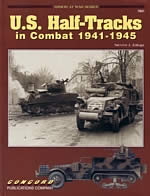 After
a four-page review of the development and implementation of armored infantry carriers,
Zaloga provides a handful of good overhead shots delineating the differences between
vehicle versions (though not as comprehensive as the Hunnicutt history). The book
then moves to a wealth of exterior battlefield shots, beginning with the M2 in
North Africa. Early variants such as the T30 with the 75mm howitzer, the M3 75mm
gun motor carriage, and the T28E1 anti-aircraft platform get good coverage. These
give way to the M15 anti-aircraft and M16 multiple gun versions as the book shifts
to Italy and Northern Europe, where the predominent carrier were the M3 and M3A1.
The photos here will
prompt modelers to pile high the gear and rations boxes. After
a four-page review of the development and implementation of armored infantry carriers,
Zaloga provides a handful of good overhead shots delineating the differences between
vehicle versions (though not as comprehensive as the Hunnicutt history). The book
then moves to a wealth of exterior battlefield shots, beginning with the M2 in
North Africa. Early variants such as the T30 with the 75mm howitzer, the M3 75mm
gun motor carriage, and the T28E1 anti-aircraft platform get good coverage. These
give way to the M15 anti-aircraft and M16 multiple gun versions as the book shifts
to Italy and Northern Europe, where the predominent carrier were the M3 and M3A1.
The photos here will
prompt modelers to pile high the gear and rations boxes.
U.S.
Half-tracks of World War II, by Steven J. Zaloga, Osprey Publications,
1983, ISBN 0-85045-481-6 ($15). 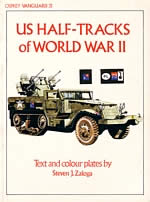 Zaloga
has also authored numerous books for Osprey over the years. Although many of the
photos herein have been reproduced elsewhere, this is a good companion to his
Concord text in that it has better detailed interior images from tech manuals
and diagrams the use of the that half-track in varying infantry company compositions
over the course of the war. Zaloga himself contributed 16 color illustrations
that don't have the sophistication and subtleties of the Concord plates but serve
as good references nonetheless. Zaloga
has also authored numerous books for Osprey over the years. Although many of the
photos herein have been reproduced elsewhere, this is a good companion to his
Concord text in that it has better detailed interior images from tech manuals
and diagrams the use of the that half-track in varying infantry company compositions
over the course of the war. Zaloga himself contributed 16 color illustrations
that don't have the sophistication and subtleties of the Concord plates but serve
as good references nonetheless.
Toadman's
M2A1 Half-track Photo Detail CD, by
Chris "toadman" Hughes, CD #16, www.toadmanstankpictures.com ($8).
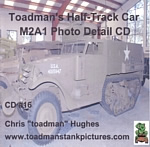 This
CD offers 230 photos of the M2A1, which used the pulpit with the .50 ring mount
rather than the skate rail of the M2. Good photos of the wiring for the front
headlights, winch, engine compartment, and underside of the vehicle. Photos of
the skate rail on an M3A1 Scout Car are included to illustrate the roller bracket
and pintle socket mount. This will be a helpful resource for modelers looking
to detail the DML M2/M2A1 half-track kit. This
CD offers 230 photos of the M2A1, which used the pulpit with the .50 ring mount
rather than the skate rail of the M2. Good photos of the wiring for the front
headlights, winch, engine compartment, and underside of the vehicle. Photos of
the skate rail on an M3A1 Scout Car are included to illustrate the roller bracket
and pintle socket mount. This will be a helpful resource for modelers looking
to detail the DML M2/M2A1 half-track kit.
WHEELED
VEHICLESDodge
Trucks in Detail, Frantisek Koran and Jan Mostek, Wings & Wheels Publications,
ISBN 80-86416-37-2 ($28). 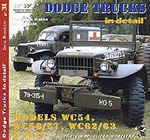 This
is an excellent visual resource of the WC-54 ambulance, WC-55/56 command car,
WC-62/63 "Big Shot, and postwar M-37 Dodge vehicles. These restorations owned
by Czech collectors offer a wealth of details for modelers. The many interior
photos of the ambulance will help anyone working on the Italeri/Bilek kit, including
shots of the stripped-down chassis and a rebuilt engine. The command car series
also provides restoration photos and nice detail of the engine compartment. The
Big Shot illustrates the chassis and numerous body features. The
only missing vehicle is the Dodge WC-51/55 "Beep," which is featured
in an earlier volume, Beep in Detail, from the same publisher. But there
is a tantalizing collage of photos from that book at the end of this book to whet
your appetite. Perhaps a bit pricey at $28 for 72 pages, but this all-color photo
album will be highly prized by Dodge fans. This
is an excellent visual resource of the WC-54 ambulance, WC-55/56 command car,
WC-62/63 "Big Shot, and postwar M-37 Dodge vehicles. These restorations owned
by Czech collectors offer a wealth of details for modelers. The many interior
photos of the ambulance will help anyone working on the Italeri/Bilek kit, including
shots of the stripped-down chassis and a rebuilt engine. The command car series
also provides restoration photos and nice detail of the engine compartment. The
Big Shot illustrates the chassis and numerous body features. The
only missing vehicle is the Dodge WC-51/55 "Beep," which is featured
in an earlier volume, Beep in Detail, from the same publisher. But there
is a tantalizing collage of photos from that book at the end of this book to whet
your appetite. Perhaps a bit pricey at $28 for 72 pages, but this all-color photo
album will be highly prized by Dodge fans.
Dodge
Military Vehicles Collection No. 1, T. Richards, ed., Brooklands Book
Distribution, Ltd., ISBN 0-946489-27-0. I
tracked this down through interlibrary loan to help detail Italeri's Dodge ambulance
kit. With the proliferation of Dodges from AFV Club (ex-Skybow) this could be
an asset if you're bent on trying to find a detail these great little kits might
have missed. ARTILLERYLight
Artillery and Anti-Tank Guns,
Easy 1 Productions, www.easy1productions.com, 2005. 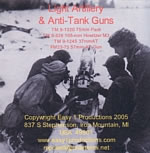 This
is a CD-ROM of manuals for several weapons: This
is a CD-ROM of manuals for several weapons:TM
9-1320 75mm Howiters and Carriage (April 1944) offers breakdown of individual
parts, but not many photos. Good for restorers and detail fanatics. TM
9-1245 37mm Gun, M3 and Carriage, M4 (January 1941) provides inspection and instructions
for repair and maintenance. Few photos, many parts diagrams. FM
23-75 57mm Gun, M1 (June 1944) examines mecahnics, usage, and tactics. Shows vulnerable
parts of tanks. Good insights on role of crew. SNL
C-36 57mm M1 on Carriage, Gun, 57mm M1A2 (1943) is the standard nomenclature listing
of parts for servicing the 57mm with both U.S. and British designations.
Also
included is a folder of manual images of various fire control instruments, from
binoculars and watches to artillery sights, periscopes, and fuse setters.
U.S.
Armored Artillery in World War II, by Steven J.
Zaloga, Concord Publications, 2002, ISBN 962-361-688-0. ($15)
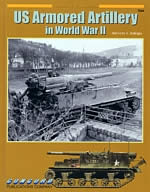 This
is a great book of neglected armored artillery: M7, M8, and M12. And since there
are at least one version of each of this self-propelled pieces in styrene, this
book could get some good use. Zaloga gives a brief over view of the development
of these AFVs and there are plenty of photos to help inspire in-action diorama
settings. The emphasis is on ETO settings, but there are several pages of Pacific
photos at the end of the book. This
is a great book of neglected armored artillery: M7, M8, and M12. And since there
are at least one version of each of this self-propelled pieces in styrene, this
book could get some good use. Zaloga gives a brief over view of the development
of these AFVs and there are plenty of photos to help inspire in-action diorama
settings. The emphasis is on ETO settings, but there are several pages of Pacific
photos at the end of the book.
U.S.
Self-Propelled Guns in Action, by Jim Mesko, Squadron/Signal Publications,
Inc., 1999, ISBN 0-89747-403-1 ($9).
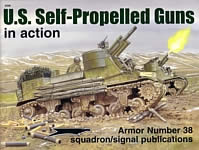 Another
nice book for beginning and intermediate modelers, There's the usual pithy analysis
of changes between vehicle variants, and black and white drawings point out distinguishing
differences. Don Greer provides a center spread of color illustrations that can
help suggest typical colors and markings. Another
nice book for beginning and intermediate modelers, There's the usual pithy analysis
of changes between vehicle variants, and black and white drawings point out distinguishing
differences. Don Greer provides a center spread of color illustrations that can
help suggest typical colors and markings.
U.S. WWII
105mm Howitzer Motor Carriages M7 & M7B1 Priest, Michael Franz, editor,
Tankograd Publishing, 2006 ($20). 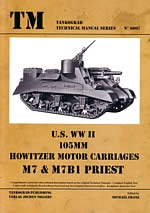 If
you want to better understand why the Italeri M7 Priest is really a late
M7, and learn how to detail it better, this will give you a good start. In 48
pages and text in English and German, it summarizes the major differences between
the two and provides a good number of images from the original technical manuals
to help you add the correct interior and exterior features to this still worthy
kit. If
you want to better understand why the Italeri M7 Priest is really a late
M7, and learn how to detail it better, this will give you a good start. In 48
pages and text in English and German, it summarizes the major differences between
the two and provides a good number of images from the original technical manuals
to help you add the correct interior and exterior features to this still worthy
kit.
Toadman's 105mm H.M.C. M7, M7B1, and M7B2 Photo
Detail CD, by Chris "toadman" Hughes, CD #15, www.toadmanstankpictures.com
($8). 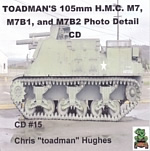 After
an introduction that gives a quick summary of the more substantial differences
between the three major variants and directs the viewer to additional references,
we get into the series of more than 370 photos, which are comprised of numerous
Priests from around the country. The photos are captioned with informative notes
that highlight particular details or differences between vehicles. Those building
the Academy M7 Priest will appreciate the shots of engine deck and the gas fume
vents missing from the model kit. These vehicles had a lot of welds on them and
the walkaround photos point these out. There are plenty of good photos of the
M3 suspension and lower hull deatils. The M7B1 has the fewest photos in the series
because other than the changes to the pulpit, transmission housing, and rear hull
plate, the vehicle remains quite similar to the M7. The M7B2, which was modified
to get greater gun elevation for the hilly terrain of Korea, gets very good coverage. After
an introduction that gives a quick summary of the more substantial differences
between the three major variants and directs the viewer to additional references,
we get into the series of more than 370 photos, which are comprised of numerous
Priests from around the country. The photos are captioned with informative notes
that highlight particular details or differences between vehicles. Those building
the Academy M7 Priest will appreciate the shots of engine deck and the gas fume
vents missing from the model kit. These vehicles had a lot of welds on them and
the walkaround photos point these out. There are plenty of good photos of the
M3 suspension and lower hull deatils. The M7B1 has the fewest photos in the series
because other than the changes to the pulpit, transmission housing, and rear hull
plate, the vehicle remains quite similar to the M7. The M7B2, which was modified
to get greater gun elevation for the hilly terrain of Korea, gets very good coverage.
AMPHIBIOUSToadman's
LVT(4) Walkaround CD, by Chris "toadman"
Hughes, CD #2, www.toadmanstankpictures.com ($8). 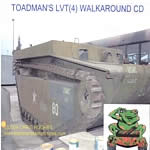 This
CD gives a nice tour of the LVT(4). After a very brief introduction on the development
of the LVT amphibians, Hughes breaks up the photo display into four sections:
hull exterior, suspension, cargo compartment, and driver's compartment. Side exterior
photos are rather limited due to close confines. There are good shots of the rear
splash deflectors, which are problematic on the Italeri kits, and a rear-facing
view of the Continental radial engine. A lot of attention is paid to details,
such as mooring posts, tie-down rings, and the gas guage. This vehicle has not
been restored but it appears fairly well intact, particularly the front cab area.
I'm not familiar with all the pitfalls of the Italeri LTV(4), but appears to be
a good reference for additional detailing. This
CD gives a nice tour of the LVT(4). After a very brief introduction on the development
of the LVT amphibians, Hughes breaks up the photo display into four sections:
hull exterior, suspension, cargo compartment, and driver's compartment. Side exterior
photos are rather limited due to close confines. There are good shots of the rear
splash deflectors, which are problematic on the Italeri kits, and a rear-facing
view of the Continental radial engine. A lot of attention is paid to details,
such as mooring posts, tie-down rings, and the gas guage. This vehicle has not
been restored but it appears fairly well intact, particularly the front cab area.
I'm not familiar with all the pitfalls of the Italeri LTV(4), but appears to be
a good reference for additional detailing. |













 Stuart:
A History of the American Light Tank, by R.P. Hunnicutt, Presidio Press,
1992, ISBN 0-89141-462-2 ($100).
Stuart:
A History of the American Light Tank, by R.P. Hunnicutt, Presidio Press,
1992, ISBN 0-89141-462-2 ($100). Kurt
Laughlin is widely respected as font of knowledge on the technical construction
and usage of U.S. AFVs of WWII. He's provided much information on this website
and to me personally for my projects. An engineer by profession, he's got an eye
for detail that is appreciated by modelers who seek to make corrections or add
the appropriate features missing from their kits. His examination of the Stuart
series, as fielded by the U.S. Army, explores the significant and subtle external
differences between the variants, from their suspensions to the tops of their
turrets. The M8 HMC gets less coverage due to the sameness of its hull to its
light tank counterparts; additional photos of the M8 turret would be welcomed
here. But if you are looking to model a specific Stuart and want to know how changes
in work orders and modifications were introduced, this provides a highly readable
narrative and lists the production date ranges, serial numbers, and registration
numbers for the vehicles, as well as their manufacturers. This is a good companion
to the other Stuart references on this page, and for many modelers it would be
an adequate substitute for the pricier and out-of-print Hunnicutt volume. Read
Kurt
Laughlin is widely respected as font of knowledge on the technical construction
and usage of U.S. AFVs of WWII. He's provided much information on this website
and to me personally for my projects. An engineer by profession, he's got an eye
for detail that is appreciated by modelers who seek to make corrections or add
the appropriate features missing from their kits. His examination of the Stuart
series, as fielded by the U.S. Army, explores the significant and subtle external
differences between the variants, from their suspensions to the tops of their
turrets. The M8 HMC gets less coverage due to the sameness of its hull to its
light tank counterparts; additional photos of the M8 turret would be welcomed
here. But if you are looking to model a specific Stuart and want to know how changes
in work orders and modifications were introduced, this provides a highly readable
narrative and lists the production date ranges, serial numbers, and registration
numbers for the vehicles, as well as their manufacturers. This is a good companion
to the other Stuart references on this page, and for many modelers it would be
an adequate substitute for the pricier and out-of-print Hunnicutt volume. Read
 If
you can't find the Hunnicutt book, this slim paperback and Steven Zaloga's Concord
publication below are the next best thing. Written in both Polish and English,
this book is thin on historical photos, but offers some eyepopping exterior and
interior details, many in color. There are also numerous scale drawings of early
and late variants. To top it off are color plates and decals for 10 Stuarts crewed
by Poles, Brits, and Americans (including the often seen "Concrete"
and "Africa" tanks). It may seem a bit pricey, but the color images
and exquisite decals make this book more than worthwhile.
If
you can't find the Hunnicutt book, this slim paperback and Steven Zaloga's Concord
publication below are the next best thing. Written in both Polish and English,
this book is thin on historical photos, but offers some eyepopping exterior and
interior details, many in color. There are also numerous scale drawings of early
and late variants. To top it off are color plates and decals for 10 Stuarts crewed
by Poles, Brits, and Americans (including the often seen "Concrete"
and "Africa" tanks). It may seem a bit pricey, but the color images
and exquisite decals make this book more than worthwhile.  Chris
provided me with a copy of this walkaround of the Stuart in the Jacques Littlefield
collection. The disc contains over 200 photos of this tank, which has been lovingly
restored. The photos are crisp and provide a wealth of details for modelers who
want to investigate every nook and cranny of the exterior and interior fighting
compartments. The only downside is that you'll want to buy a laptop so you can
have quick access to this great reference as you're building.
Chris
provided me with a copy of this walkaround of the Stuart in the Jacques Littlefield
collection. The disc contains over 200 photos of this tank, which has been lovingly
restored. The photos are crisp and provide a wealth of details for modelers who
want to investigate every nook and cranny of the exterior and interior fighting
compartments. The only downside is that you'll want to buy a laptop so you can
have quick access to this great reference as you're building. This
is another great pictorial book of the Stuart variants and follow-on Chaffees
in combat settings. Zaloga goes over the development of the U.S. light tank in
three concise pages and offers some interesting photos of the early M1 combat
car and M2 light tank, which led the way to the M3 series. Early combat in North
Africa and the Far East is shown before the bulk of the book moves to Italy and
Northern Europe. The Chaffee appears in 1944, and there are a few photos of the
Locust airborne tank. The book includes 16 color plates.
This
is another great pictorial book of the Stuart variants and follow-on Chaffees
in combat settings. Zaloga goes over the development of the U.S. light tank in
three concise pages and offers some interesting photos of the early M1 combat
car and M2 light tank, which led the way to the M3 series. Early combat in North
Africa and the Far East is shown before the bulk of the book moves to Italy and
Northern Europe. The Chaffee appears in 1944, and there are a few photos of the
Locust airborne tank. The book includes 16 color plates. The
M24 doesn't get many props for its role as the replacement for the M5 Stuart as
the main light recon tank in the closing months of WWII. Perhaps that's due in
part to the initial Italeri kit from the early 1980s, based on a Korean version.
The company's reworking of the kit to WWII standards some 20 years later still
has some minor problems. A resin update set from Formations replaces most of the
Italeri kit. But any of these kits will benefift from having this CD close at
hand. Toadman offers walk-arounds of four different M24s. Along with the usual
photos of exterior details, this album also includes some fantstic interior photos
of the drivers' positions in the hull, the turret, and the engine compartment.
Thanks to Chris for the review sample.
The
M24 doesn't get many props for its role as the replacement for the M5 Stuart as
the main light recon tank in the closing months of WWII. Perhaps that's due in
part to the initial Italeri kit from the early 1980s, based on a Korean version.
The company's reworking of the kit to WWII standards some 20 years later still
has some minor problems. A resin update set from Formations replaces most of the
Italeri kit. But any of these kits will benefift from having this CD close at
hand. Toadman offers walk-arounds of four different M24s. Along with the usual
photos of exterior details, this album also includes some fantstic interior photos
of the drivers' positions in the hull, the turret, and the engine compartment.
Thanks to Chris for the review sample. This
is THE book, at long last in print again, detailing the technical development
of the medium tank, from the M3 Lee through the Sherman's last action in the Korean
War. Chocked full of engineering details, it offers more to the serious modeler
interested in hardware and mechanical minutiae than probably any other book. For
more casual modelers, it may be overkill. But many of the surface differences
between variants are capably covered by other books, and other volumes have more
extensive photograph collections.
This
is THE book, at long last in print again, detailing the technical development
of the medium tank, from the M3 Lee through the Sherman's last action in the Korean
War. Chocked full of engineering details, it offers more to the serious modeler
interested in hardware and mechanical minutiae than probably any other book. For
more casual modelers, it may be overkill. But many of the surface differences
between variants are capably covered by other books, and other volumes have more
extensive photograph collections. This
book is an excellent complement to Hunnicutt's "bible." Zaloga briefly
covers the development of the Sherman, but most of his focus is on how the tank
performed on the battlefield and how armored doctrine and tactics were recast
as the tank came up against German and Japanese armor. Photos run from pre-war
predecessors up to the final Cold War variants, picking up Tunisia, Italy, Tarawa,
Normandy, the Bulge, and Iwo Jima along the way. A number of pictures have graced
other Zaloga books, but there are many fresh combat images. For the wonks among
us, there are plenty of strength and loss stats and production runs at the various
factories, if you want to make sure your Archer Fine Transfer casting marks are
on the right tank at the right time. If you're interested in how the Sherman helped
the Allies prevail on the battlefield against techically superior armor, this
book will school you.
This
book is an excellent complement to Hunnicutt's "bible." Zaloga briefly
covers the development of the Sherman, but most of his focus is on how the tank
performed on the battlefield and how armored doctrine and tactics were recast
as the tank came up against German and Japanese armor. Photos run from pre-war
predecessors up to the final Cold War variants, picking up Tunisia, Italy, Tarawa,
Normandy, the Bulge, and Iwo Jima along the way. A number of pictures have graced
other Zaloga books, but there are many fresh combat images. For the wonks among
us, there are plenty of strength and loss stats and production runs at the various
factories, if you want to make sure your Archer Fine Transfer casting marks are
on the right tank at the right time. If you're interested in how the Sherman helped
the Allies prevail on the battlefield against techically superior armor, this
book will school you.
 Nearly
any book by Steve Zaloga is worth having on your shelf. These two Concord publications
follow the same structure: several pages of narrative overview and then loads
of pictures, including color illustrations. Both books will provide keen insights
for modelers and diorama builders.
Nearly
any book by Steve Zaloga is worth having on your shelf. These two Concord publications
follow the same structure: several pages of narrative overview and then loads
of pictures, including color illustrations. Both books will provide keen insights
for modelers and diorama builders. In
my opinion, Michael Green is right up there with Zaloga for producing books of
great interest to modelers. They tend to be heavier on the narrative side than
Zaloga's, but that's not a bad thing. The firsthand tank crew accounts are compelling
and provide a human dimension to these mechanical beasts. This book has many useful
interior photos of the Sherman variants, and a number of historical and contemporary
exterior photos are in color. Coverage extends to the Korean War and Israeli usage.
In
my opinion, Michael Green is right up there with Zaloga for producing books of
great interest to modelers. They tend to be heavier on the narrative side than
Zaloga's, but that's not a bad thing. The firsthand tank crew accounts are compelling
and provide a human dimension to these mechanical beasts. This book has many useful
interior photos of the Sherman variants, and a number of historical and contemporary
exterior photos are in color. Coverage extends to the Korean War and Israeli usage.%20HVSS.jpg) Insert
this CD-ROM into your computer and you're instantly transported to the Military
Vehicle Technology Foundation in California, home of the infamous Jacques Littlefield
collection. You get up close and friendly with an M4A3(76) and M4A2(76) in fine
condition. There are approximately 400 photos on this disc covering the essential
attributes of these tanks, and Hughes points out similarities and differences
between the two where applicable. There's no deep historical or technical analysis
here; this is a visual feast for the modeler who wants to get the lift ring weld
seams right or install the brackets that secure the exhaust deflectors when work
is done on the rear of the tank, so each photo has only a brief identifying comment.
Alternate types of tracks and drive sprockets are shown, and there are great interior
photos of the hull and turret, but no engine compartment images. If you want to
know what three (or four) colors to paint your periscopes, this is the guide for
you.
Insert
this CD-ROM into your computer and you're instantly transported to the Military
Vehicle Technology Foundation in California, home of the infamous Jacques Littlefield
collection. You get up close and friendly with an M4A3(76) and M4A2(76) in fine
condition. There are approximately 400 photos on this disc covering the essential
attributes of these tanks, and Hughes points out similarities and differences
between the two where applicable. There's no deep historical or technical analysis
here; this is a visual feast for the modeler who wants to get the lift ring weld
seams right or install the brackets that secure the exhaust deflectors when work
is done on the rear of the tank, so each photo has only a brief identifying comment.
Alternate types of tracks and drive sprockets are shown, and there are great interior
photos of the hull and turret, but no engine compartment images. If you want to
know what three (or four) colors to paint your periscopes, this is the guide for
you. This
slim volume is a good introduction to some of the mechanical features of these
Sherman variants wihtout sinking an arm and a leg into the Hunnicutt tome. In
48 pages and text in English and German, it offers a strong selection of images
from the original technical manuals that can help you represent the essential
interior layouts to satisfy "through the hatch" viewing. It also includes
some images of the 105mm howitzer turret and gun mount, and a good section on
the deep water fording kit. Images of the flamethrower M42B1 are interesting,
but a couple shots of an M4 with the T1E3 mine-roller and photo of bulldozer mounted
on an M4A1(76)W are somewhat superfluous.
This
slim volume is a good introduction to some of the mechanical features of these
Sherman variants wihtout sinking an arm and a leg into the Hunnicutt tome. In
48 pages and text in English and German, it offers a strong selection of images
from the original technical manuals that can help you represent the essential
interior layouts to satisfy "through the hatch" viewing. It also includes
some images of the 105mm howitzer turret and gun mount, and a good section on
the deep water fording kit. Images of the flamethrower M42B1 are interesting,
but a couple shots of an M4 with the T1E3 mine-roller and photo of bulldozer mounted
on an M4A1(76)W are somewhat superfluous. This
is among the earliest of the series of slim "In Actoin" books from Squadron/Signal
Publications. They provide an inexpensive entry point for the modeler just beginning
to get into specific U.S. armor vehicles. There's always a pithy analysis of changes
between vehicle variants, and black and white drawings point out distinguishing
differences. Illustrator Don Greer provides a center color spread of eight tanks
that can help determine typical colors and markings.
This
is among the earliest of the series of slim "In Actoin" books from Squadron/Signal
Publications. They provide an inexpensive entry point for the modeler just beginning
to get into specific U.S. armor vehicles. There's always a pithy analysis of changes
between vehicle variants, and black and white drawings point out distinguishing
differences. Illustrator Don Greer provides a center color spread of eight tanks
that can help determine typical colors and markings.  The
M10 and M36 series are well represented in action photos, along with the M18 Hellcat
and the short-lived M3 75mm Gun Motor Carriage (built on the M3 halftrack) and
M6 37mm GMC (using the Dodge 3/4 ton weapons carrier as a platform). Sixteen plates
of color illustrations, including two M36s from the Croatian army during the early
1990s fighting in the Balkans.
The
M10 and M36 series are well represented in action photos, along with the M18 Hellcat
and the short-lived M3 75mm Gun Motor Carriage (built on the M3 halftrack) and
M6 37mm GMC (using the Dodge 3/4 ton weapons carrier as a platform). Sixteen plates
of color illustrations, including two M36s from the Croatian army during the early
1990s fighting in the Balkans. These
slim books from Squadron/Signal Publications are fantastic for the modeler just
beginning to get into U.S. Armor or specific vehicles. There's always a pithy
analysis of changes between vehicle variants, and black and white drawings point
out distinguishing differences. There's always a center spread of color illustrations
by Don Greer that can help determine typical colors and markings.
These
slim books from Squadron/Signal Publications are fantastic for the modeler just
beginning to get into U.S. Armor or specific vehicles. There's always a pithy
analysis of changes between vehicle variants, and black and white drawings point
out distinguishing differences. There's always a center spread of color illustrations
by Don Greer that can help determine typical colors and markings.  The
third in the "Walk Around" series from Squadron, this book is a good
companion to Mesko's U.S. Tank Destroyers in Action. There is plenty of
color photos interspersed among the B&W shots of the interiors and exteriors
of the M10, M10A1, M18, and M36 series of tank busters. Most of the photos are
of restored vehicles, as well as a few historical images. There a few line drawings
from Darren Glenn and Dave Gebhardt, and fourteen color illustrations from Don
Greer. This book will help modelers who want to do some extra detailing, particularly
of the interiors of these open-topped turrets. The only significant omissions
I found were an absence of photos of the ammo layout in the M36 and M36B2. In
these vehicles, changes in the M10 hull layout were necessary to accommodate the
longer 90mm rounds stowed on the hull sponsons. However, there are a couple photos
of the ammo stowage areas on the sponsons of the M36B1, the briefly produced version
which used the Sherman hull. All in all, it's not as exhaustive as a Hunnicutt
study, but it's enough for most modelers and at a very reasonable price.
The
third in the "Walk Around" series from Squadron, this book is a good
companion to Mesko's U.S. Tank Destroyers in Action. There is plenty of
color photos interspersed among the B&W shots of the interiors and exteriors
of the M10, M10A1, M18, and M36 series of tank busters. Most of the photos are
of restored vehicles, as well as a few historical images. There a few line drawings
from Darren Glenn and Dave Gebhardt, and fourteen color illustrations from Don
Greer. This book will help modelers who want to do some extra detailing, particularly
of the interiors of these open-topped turrets. The only significant omissions
I found were an absence of photos of the ammo layout in the M36 and M36B2. In
these vehicles, changes in the M10 hull layout were necessary to accommodate the
longer 90mm rounds stowed on the hull sponsons. However, there are a couple photos
of the ammo stowage areas on the sponsons of the M36B1, the briefly produced version
which used the Sherman hull. All in all, it's not as exhaustive as a Hunnicutt
study, but it's enough for most modelers and at a very reasonable price.
 With
fewer variants and mechanical complexities, this book comes in at (appropriately)
half the size of the fully tracked Sherman and Stuart books penned
by Hunnicutt. What makes it particularly valuable to modelers is the wealth of
interior photos, detailed tech manual images of various components, five-view
drawings from Michael Duplessis, and a concise narrative outlining the vehicle's
development from WWI to Korea. An excellent companion for the new DML kits—or
those old Tamiya models you might wish to upgrade.
With
fewer variants and mechanical complexities, this book comes in at (appropriately)
half the size of the fully tracked Sherman and Stuart books penned
by Hunnicutt. What makes it particularly valuable to modelers is the wealth of
interior photos, detailed tech manual images of various components, five-view
drawings from Michael Duplessis, and a concise narrative outlining the vehicle's
development from WWI to Korea. An excellent companion for the new DML kits—or
those old Tamiya models you might wish to upgrade. After
a four-page review of the development and implementation of armored infantry carriers,
Zaloga provides a handful of good overhead shots delineating the differences between
vehicle versions (though not as comprehensive as the Hunnicutt history). The book
then moves to a wealth of exterior battlefield shots, beginning with the M2 in
North Africa. Early variants such as the T30 with the 75mm howitzer, the M3 75mm
gun motor carriage, and the T28E1 anti-aircraft platform get good coverage. These
give way to the M15 anti-aircraft and M16 multiple gun versions as the book shifts
to Italy and Northern Europe, where the predominent carrier were the M3 and M3A1.
The photos here will
prompt modelers to pile high the gear and rations boxes.
After
a four-page review of the development and implementation of armored infantry carriers,
Zaloga provides a handful of good overhead shots delineating the differences between
vehicle versions (though not as comprehensive as the Hunnicutt history). The book
then moves to a wealth of exterior battlefield shots, beginning with the M2 in
North Africa. Early variants such as the T30 with the 75mm howitzer, the M3 75mm
gun motor carriage, and the T28E1 anti-aircraft platform get good coverage. These
give way to the M15 anti-aircraft and M16 multiple gun versions as the book shifts
to Italy and Northern Europe, where the predominent carrier were the M3 and M3A1.
The photos here will
prompt modelers to pile high the gear and rations boxes.  Zaloga
has also authored numerous books for Osprey over the years. Although many of the
photos herein have been reproduced elsewhere, this is a good companion to his
Concord text in that it has better detailed interior images from tech manuals
and diagrams the use of the that half-track in varying infantry company compositions
over the course of the war. Zaloga himself contributed 16 color illustrations
that don't have the sophistication and subtleties of the Concord plates but serve
as good references nonetheless.
Zaloga
has also authored numerous books for Osprey over the years. Although many of the
photos herein have been reproduced elsewhere, this is a good companion to his
Concord text in that it has better detailed interior images from tech manuals
and diagrams the use of the that half-track in varying infantry company compositions
over the course of the war. Zaloga himself contributed 16 color illustrations
that don't have the sophistication and subtleties of the Concord plates but serve
as good references nonetheless. This
CD offers 230 photos of the M2A1, which used the pulpit with the .50 ring mount
rather than the skate rail of the M2. Good photos of the wiring for the front
headlights, winch, engine compartment, and underside of the vehicle. Photos of
the skate rail on an M3A1 Scout Car are included to illustrate the roller bracket
and pintle socket mount. This will be a helpful resource for modelers looking
to detail the DML M2/M2A1 half-track kit.
This
CD offers 230 photos of the M2A1, which used the pulpit with the .50 ring mount
rather than the skate rail of the M2. Good photos of the wiring for the front
headlights, winch, engine compartment, and underside of the vehicle. Photos of
the skate rail on an M3A1 Scout Car are included to illustrate the roller bracket
and pintle socket mount. This will be a helpful resource for modelers looking
to detail the DML M2/M2A1 half-track kit. This
is an excellent visual resource of the WC-54 ambulance, WC-55/56 command car,
WC-62/63 "Big Shot, and postwar M-37 Dodge vehicles. These restorations owned
by Czech collectors offer a wealth of details for modelers. The many interior
photos of the ambulance will help anyone working on the Italeri/Bilek kit, including
shots of the stripped-down chassis and a rebuilt engine. The command car series
also provides restoration photos and nice detail of the engine compartment. The
Big Shot illustrates the chassis and numerous body features. The
only missing vehicle is the Dodge WC-51/55 "Beep," which is featured
in an earlier volume, Beep in Detail, from the same publisher. But there
is a tantalizing collage of photos from that book at the end of this book to whet
your appetite. Perhaps a bit pricey at $28 for 72 pages, but this all-color photo
album will be highly prized by Dodge fans.
This
is an excellent visual resource of the WC-54 ambulance, WC-55/56 command car,
WC-62/63 "Big Shot, and postwar M-37 Dodge vehicles. These restorations owned
by Czech collectors offer a wealth of details for modelers. The many interior
photos of the ambulance will help anyone working on the Italeri/Bilek kit, including
shots of the stripped-down chassis and a rebuilt engine. The command car series
also provides restoration photos and nice detail of the engine compartment. The
Big Shot illustrates the chassis and numerous body features. The
only missing vehicle is the Dodge WC-51/55 "Beep," which is featured
in an earlier volume, Beep in Detail, from the same publisher. But there
is a tantalizing collage of photos from that book at the end of this book to whet
your appetite. Perhaps a bit pricey at $28 for 72 pages, but this all-color photo
album will be highly prized by Dodge fans. This
is a CD-ROM of manuals for several weapons:
This
is a CD-ROM of manuals for several weapons: This
is a great book of neglected armored artillery: M7, M8, and M12. And since there
are at least one version of each of this self-propelled pieces in styrene, this
book could get some good use. Zaloga gives a brief over view of the development
of these AFVs and there are plenty of photos to help inspire in-action diorama
settings. The emphasis is on ETO settings, but there are several pages of Pacific
photos at the end of the book.
This
is a great book of neglected armored artillery: M7, M8, and M12. And since there
are at least one version of each of this self-propelled pieces in styrene, this
book could get some good use. Zaloga gives a brief over view of the development
of these AFVs and there are plenty of photos to help inspire in-action diorama
settings. The emphasis is on ETO settings, but there are several pages of Pacific
photos at the end of the book. Another
nice book for beginning and intermediate modelers, There's the usual pithy analysis
of changes between vehicle variants, and black and white drawings point out distinguishing
differences. Don Greer provides a center spread of color illustrations that can
help suggest typical colors and markings.
Another
nice book for beginning and intermediate modelers, There's the usual pithy analysis
of changes between vehicle variants, and black and white drawings point out distinguishing
differences. Don Greer provides a center spread of color illustrations that can
help suggest typical colors and markings. If
you want to better understand why the Italeri M7 Priest is really a late
M7, and learn how to detail it better, this will give you a good start. In 48
pages and text in English and German, it summarizes the major differences between
the two and provides a good number of images from the original technical manuals
to help you add the correct interior and exterior features to this still worthy
kit.
If
you want to better understand why the Italeri M7 Priest is really a late
M7, and learn how to detail it better, this will give you a good start. In 48
pages and text in English and German, it summarizes the major differences between
the two and provides a good number of images from the original technical manuals
to help you add the correct interior and exterior features to this still worthy
kit. After
an introduction that gives a quick summary of the more substantial differences
between the three major variants and directs the viewer to additional references,
we get into the series of more than 370 photos, which are comprised of numerous
Priests from around the country. The photos are captioned with informative notes
that highlight particular details or differences between vehicles. Those building
the Academy M7 Priest will appreciate the shots of engine deck and the gas fume
vents missing from the model kit. These vehicles had a lot of welds on them and
the walkaround photos point these out. There are plenty of good photos of the
M3 suspension and lower hull deatils. The M7B1 has the fewest photos in the series
because other than the changes to the pulpit, transmission housing, and rear hull
plate, the vehicle remains quite similar to the M7. The M7B2, which was modified
to get greater gun elevation for the hilly terrain of Korea, gets very good coverage.
After
an introduction that gives a quick summary of the more substantial differences
between the three major variants and directs the viewer to additional references,
we get into the series of more than 370 photos, which are comprised of numerous
Priests from around the country. The photos are captioned with informative notes
that highlight particular details or differences between vehicles. Those building
the Academy M7 Priest will appreciate the shots of engine deck and the gas fume
vents missing from the model kit. These vehicles had a lot of welds on them and
the walkaround photos point these out. There are plenty of good photos of the
M3 suspension and lower hull deatils. The M7B1 has the fewest photos in the series
because other than the changes to the pulpit, transmission housing, and rear hull
plate, the vehicle remains quite similar to the M7. The M7B2, which was modified
to get greater gun elevation for the hilly terrain of Korea, gets very good coverage. This
CD gives a nice tour of the LVT(4). After a very brief introduction on the development
of the LVT amphibians, Hughes breaks up the photo display into four sections:
hull exterior, suspension, cargo compartment, and driver's compartment. Side exterior
photos are rather limited due to close confines. There are good shots of the rear
splash deflectors, which are problematic on the Italeri kits, and a rear-facing
view of the Continental radial engine. A lot of attention is paid to details,
such as mooring posts, tie-down rings, and the gas guage. This vehicle has not
been restored but it appears fairly well intact, particularly the front cab area.
I'm not familiar with all the pitfalls of the Italeri LTV(4), but appears to be
a good reference for additional detailing.
This
CD gives a nice tour of the LVT(4). After a very brief introduction on the development
of the LVT amphibians, Hughes breaks up the photo display into four sections:
hull exterior, suspension, cargo compartment, and driver's compartment. Side exterior
photos are rather limited due to close confines. There are good shots of the rear
splash deflectors, which are problematic on the Italeri kits, and a rear-facing
view of the Continental radial engine. A lot of attention is paid to details,
such as mooring posts, tie-down rings, and the gas guage. This vehicle has not
been restored but it appears fairly well intact, particularly the front cab area.
I'm not familiar with all the pitfalls of the Italeri LTV(4), but appears to be
a good reference for additional detailing.